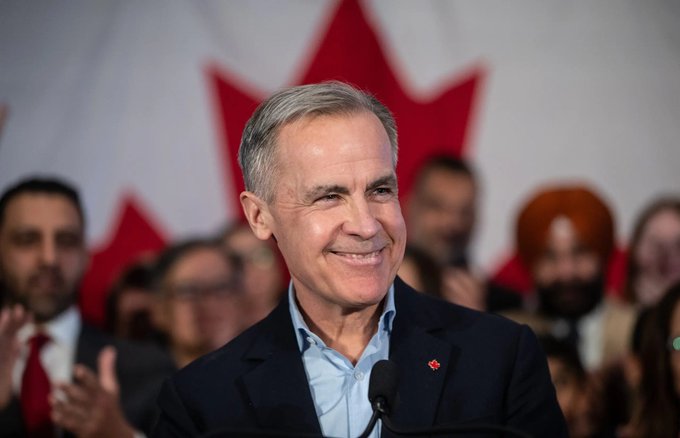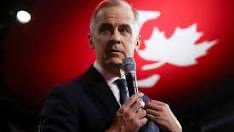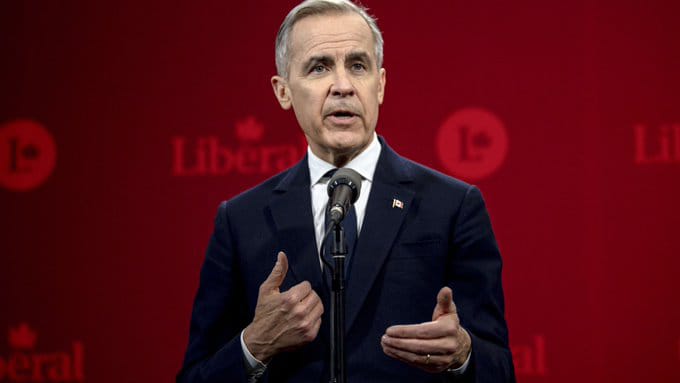Ottawa, March 10, 2025
A fiery inaugural address following his landslide election as Canada’s Prime Minister, Mark Carney launched a scathing critique of former U.S. President Donald Trump, accusing him of waging an “economic assault” on Canadian workers and businesses through aggressive tariff policies. Carney’s defiant speech signals a dramatic escalation in cross-border tensions, with retaliatory measures poised to reshape North American trade dynamics.

Canada’s New PM Mark Carney Vows Retaliation Against Trump’s Tariffs in Fiery Victory Speech
Newly elected Canadian Prime Minister Mark Carney struck a combative tone in his inaugural address, directly confronting former U.S. President Donald Trump over escalating trade tensions.
Carney, who secured a landslide victory with 85.9% of Liberal Party votes, accused Trump of “economic aggression” through “unjustified tariffs” targeting Canadian industries.
“We will not stand by as American policies attack our workers and businesses,” declared Carney, pledging retaliatory measures designed to maximize U.S. economic pain, particularly in agriculture and manufacturing sectors.
His speech emphasized sovereignty, vowing to diversify trade partnerships with the EU and Asia while securing Canada’s borders against resource disputes.
Economic Reckoning and Strategic Shifts
Carney’s strategy signals a seismic shift in Canada’s approach to U.S. relations, prioritizing defiance over decades of economic interdependence.
Analysts warn that retaliatory tariffs could destabilize the $750 billion annual bilateral trade relationship, critical to auto and energy sectors. However, Carney, leveraging his central banking expertise, framed the move as necessary to counter Trump’s “annexation rhetoric” and protect Canada’s resources.
Plans include fast-tracking critical mineral deals with Germany and boosting tech alliances with South Korea to reduce reliance on U.S. markets. Critics argue the gamble risks alienating rural provinces dependent on cross-border trade, while supporters hail it as a long-overdue assertion of independence.

Political Uncertainty Looming
Despite his decisive mandate, Carney faces a precarious political landscape. National polls show the opposition Conservatives leading by 3%, raising speculation of a snap election before October.
While his anti-Trump stance energizes urban progressives, it may falter in swing regions like Alberta, where 60% of exports flow to the U.S. Carney’s ability to sustain momentum hinges on delivering economic stability amid trade chaos—a challenge compounded by Trump’s unpredictable tariff threats.
As Canada braces for a pivotal year, the world watches whether Carney’s bold strategy will redefine North American trade or deepen its most consequential rift in modern history.
Carney’s Defiant Stance Against US Tariffs
Addressing a packed Parliament, Carney condemned Trump’s recent tariffs as “unjustified and destructive,” warning of “dark days ahead” if the U.S. continues its economic policies. “This is not just about trade—it’s about sovereignty,” declared Carney, a former Bank of England and Bank of Canada governor. “We will not let Washington dictate terms while attacking Canadian families and industries.”
Key pledges from Carney’s speech include:
- Retaliatory tariffs targeting U.S. agricultural and manufacturing sectors.
- Accelerated efforts to diversify trade partnerships with the EU, Asia, and Latin America.
- A C$10 billion border security fund to counter potential U.S. resource disputes.

Economic Strategy & Retaliation
Carney emphasized Canada’s intent to leverage its critical mineral reserves and energy exports as geopolitical tools. “The U.S. wants our resources without respecting our sovereignty,” he stated. Analysts suggest this could impact Biden-era agreements on electric vehicle supply chains.
The new PM’s strategy aligns with recent polls showing 68% of Canadians support tougher trade actions against the U.S. However, critics warn that prolonged tariffs could harm Canada’s auto sector, which contributes 10% of national GDP.
Table of Contents
Political Landscape Ahead of 2025 Elections
Despite his decisive victory (85.9% of Liberal Party votes), Carney faces a fractured Parliament. Opposition Conservatives currently lead national polls at 41%, versus 38% for the Liberals. Political scientist Dr. Laura Dawson notes, “Carney’s anti-Trump rhetoric rallies his base but risks alienating rural voters dependent on U.S. trade.”

US-Canada Relations at a Crossroads
Trump’s calls to “annex Canada” and erratic tariff moves have strained relations since 2024. Carney’s administration now faces pressure to:
- Renegotiate the USMCA trade pact.
- Secure alternative markets for Canada’s $420 billion annual U.S. exports.
- Address rising protectionism in Quebec and Alberta.
Q: How will Carney’s tariffs impact US-Canada trade?
A: Retaliatory measures could disrupt $750 billion in annual bilateral trade, particularly in automotive and agriculture sectors.
Q: What are Canada’s new trade alliances under Carney?
A: Expect accelerated deals with Germany (critical minerals) and South Korea (AI/tech partnerships).
Q: Could Canada’s elections change this strategy?
A: Yes—if Conservatives win October’s snap election, leader Pierre Poilievre may prioritize US relations over confrontation.


